OCZ Vertex 3 (240GB) Review
by Anand Lal Shimpi on May 6, 2011 1:50 AM ESTRandom Read/Write Speed
The four corners of SSD performance are as follows: random read, random write, sequential read and sequential write speed. Random accesses are generally small in size, while sequential accesses tend to be larger and thus we have the four Iometer tests we use in all of our reviews.
Our first test writes 4KB in a completely random pattern over an 8GB space of the drive to simulate the sort of random access that you'd see on an OS drive (even this is more stressful than a normal desktop user would see). I perform three concurrent IOs and run the test for 3 minutes. The results reported are in average MB/s over the entire time. We use both standard pseudo randomly generated data for each write as well as fully random data to show you both the maximum and minimum performance offered by SandForce based drives in these tests. The average performance of SF drives will likely be somewhere in between the two values for each drive you see in the graphs. For an understanding of why this matters, read our original SandForce article.
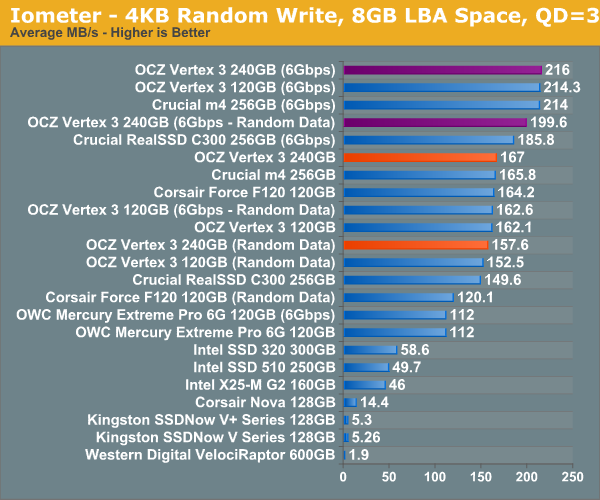
Many of you have asked for random write performance at higher queue depths. What I have below is our 4KB random write test performed at a queue depth of 32 instead of 3. While the vast majority of desktop usage models experience queue depths of 0 - 5, higher depths are possible in heavy I/O (and multi-user) workloads:
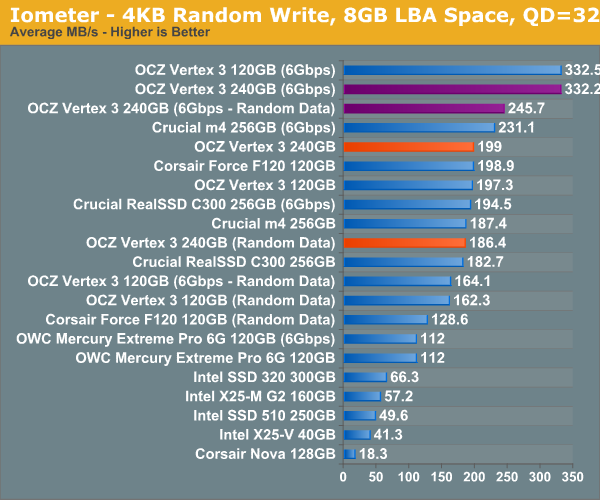
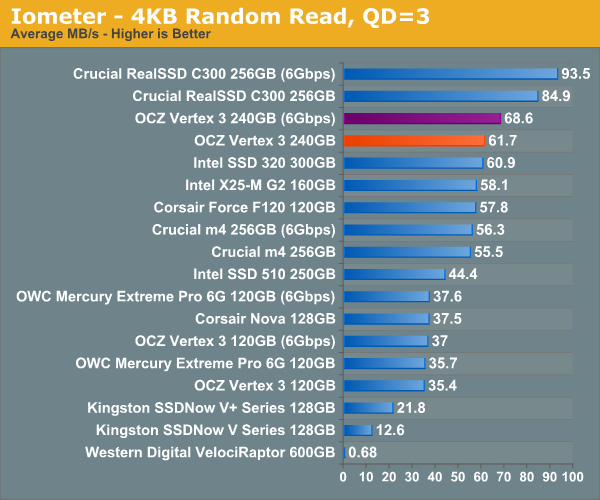
Sequential Read/Write Speed
To measure sequential performance I ran a 1 minute long 128KB sequential test over the entire span of the drive at a queue depth of 1. The results reported are in average MB/s over the entire test length.
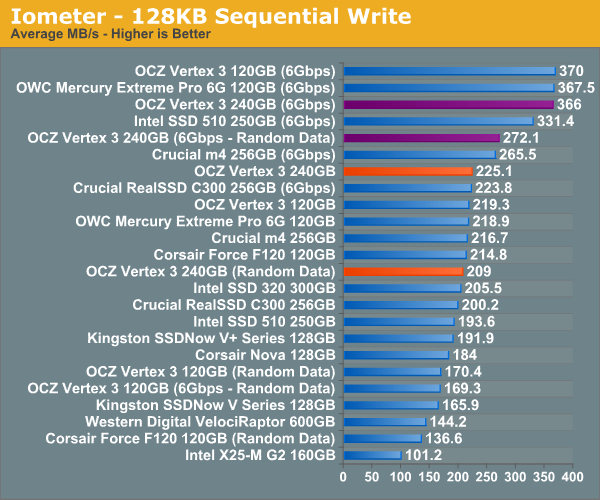
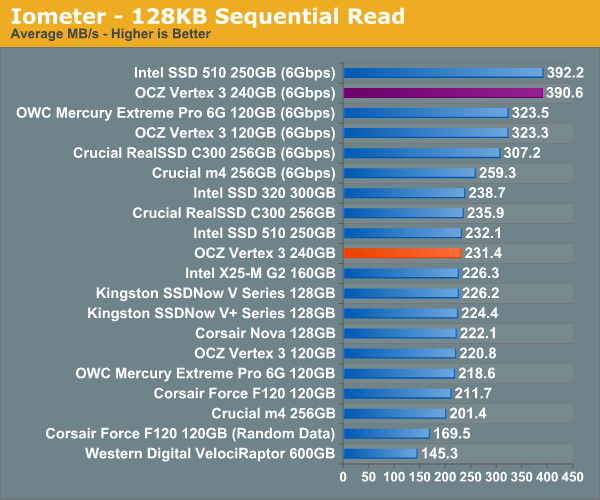










90 Comments
View All Comments
Just3r1d7 - Saturday, May 7, 2011 - link
Dear Anand,I have been carefully reading SSD articles for the past 18 months waiting for the right time to make a purchase for both my home and work PCs... The depth and breadth of SSD coverage on AnandTech has been stellar, and this latest Vertex 3 review is no exception.
It's clear that the Vertex 3 240GB is the "best performing" drive for $500. However, as other posters have noted, all of the information floating around about SSDs hasn't necessarily resulted in clear guidelines or practical recommendations.
My guess is that the "average" user isn't going to spend $500 on an SSD for their home PC... Thus, as you continue to conduct these reviews, it may be helpful to compile a table/chart to guide your dedicated readers (and anyone else who browses the site). This would also have the benefit of reducing the number of "I have Processor A, Chipset B, and Operating System C, which SSD should I buy?" questions that arise.
Here are a few examples of questions which seem to come up repeatedly and could probably be answered by a summary table of recommendations based on drives currently available in retail channels:
1. What is the best "small" capacity drive? (at any cost)
2. What is the best "low cost" drive? (at any capacity)
3. What is the best performing OS/application drive?
4. What is the best drive for non-TRIM supported OS? (e.g. WinXP or Mac)
5. What is the best (most reliable) drive for a business PC?
Just some food for thought... Keep up the great work on the SSD coverage and reviews!
-Bob
Wardrop - Saturday, May 7, 2011 - link
Anyone know when OCZ will refresh their RevoDrive line with SF2xxx controllers? I'll be getting one of them.iwod - Sunday, May 8, 2011 - link
In an ideal world, the NAND would get smaller every node shrink, and we could fit more die inside an NAND package.However with every die shrink they also double the capacity of the minimum die size. i.e from 64Gbit to 128 Gbit ... etc
If 8 Channel and 8 NAND Package being a constant factor, we are only going to get more capacity at the same price, but not lower price at lower capacity.
Is there any reason behind this?
And that is why when i see people saying i will wait for SSD to drop below $50 etc.... They are halving the price every year so i will wait a year or two before i get it. The truth is it is never going to happen. The absolute minimum BOM *equation* for SSD has stay constant for years. Unless the minimum price per NAND die is going to drop, may be what we see today is already the absolute minimum price / SSD we will ever see?
ibliblibli - Sunday, May 8, 2011 - link
A thorough review, but I'd like to understand why the HDTach charts showing the read-and-write performance before-torture, after-torture and post-TRIM are not shown. I know the average sustained writes do not change much even after torturing the drive, but I'm interested in the volatility. None of other the articles covering the latest Sand Force drives (OCZ Vertex 3 Pro/Non-Pro 240 GB Previews, OCZ Vertex 3 120 GB Review, OWC Mercury Extreme Pro 6G Review) show this data either. However, the reviews for the other new drives (Intel 510, Intel 320 and Crucial m4) includes those charts. Is there a reason for this exclusion? The information from those charts is helpful.NorthShoreExile - Monday, May 9, 2011 - link
Based on the initial review, I ordered one for my new build. It took weeks to arrive but I finally got it. All I can say is "WOW"! It is everything it claims to be.jinino - Monday, May 9, 2011 - link
Great review Anand,From the photo in the last page, I see the disk is made in Taiwan. Do you happen to know that OCZ's SSD is manufactured by the same OEM in Taiwan as the manufacturer for Intel's SSD?
alpha754293 - Monday, May 9, 2011 - link
Wonderful review on the OCZ Vertex 3 SSD.I was wondering if you might be able to run the full h2benchw benchmark on the drive?
You should be able to download it here:
http://www.heise.de/software/download/h2benchw/378... or just google it.
Can you post or email me the results please?
Thank you.
ueharaf - Tuesday, May 10, 2011 - link
what is the difference between vertex 3 and solid 3?http://www.ocztechnology.com/ocz-solid-3-sata-iii-...
sanguy - Tuesday, May 10, 2011 - link
Hi,We just received 5 Vertex 3 240GB drives for installation into some Dell E6520 laptops. We did the install but with the Vertex 3 installed we've been having random system lock-ups that require a hard boot.
We are in AHCI mode in the bios and running Windows 7x64 with the 10.1 Intel RST drivers. Drives are firmware 2.02.
We are seeing this on several laptops/drives so it's not a one off.
Drive is detected by the toolkit OCZ has available, and RST reports it correct at 6Gbps.
These are sandy bridge quad core laptops using a 6 series chipset.
Anyone seeing compatibility issues? I did find a thread at OCZ over disabling some function in the registry which we did without it solving the issue.
DanaG - Wednesday, May 11, 2011 - link
I'd say Sandforce drives are just plain buggy, if you try to do anything non-desktop with them. (Even my old Indilinx drive was more stable.)From what you're seeing, the new ones must be even worse than the old ones.
Check my comments on Page 6, and this link:
http://www.ocztechnologyforum.com/forum/showthread...